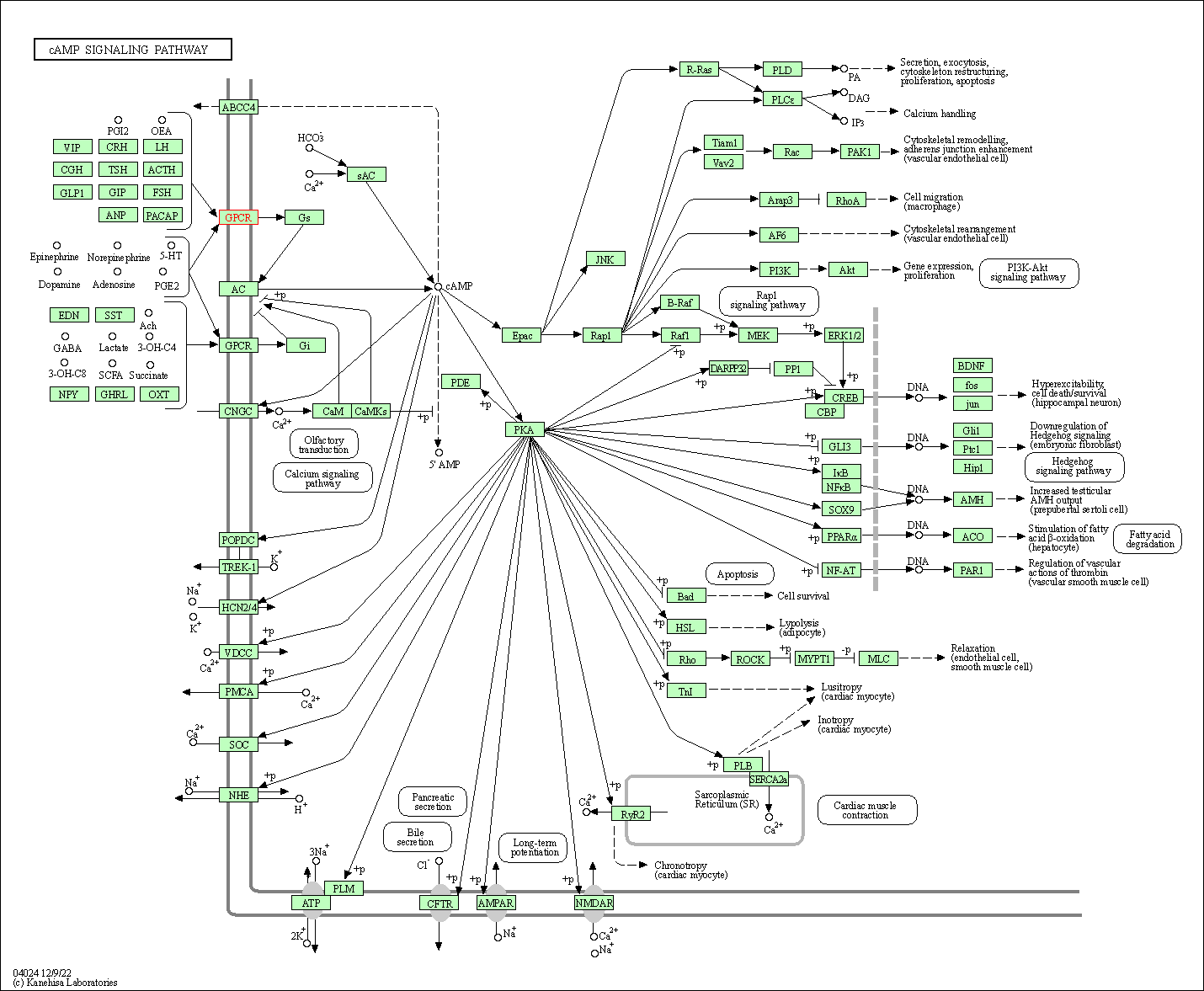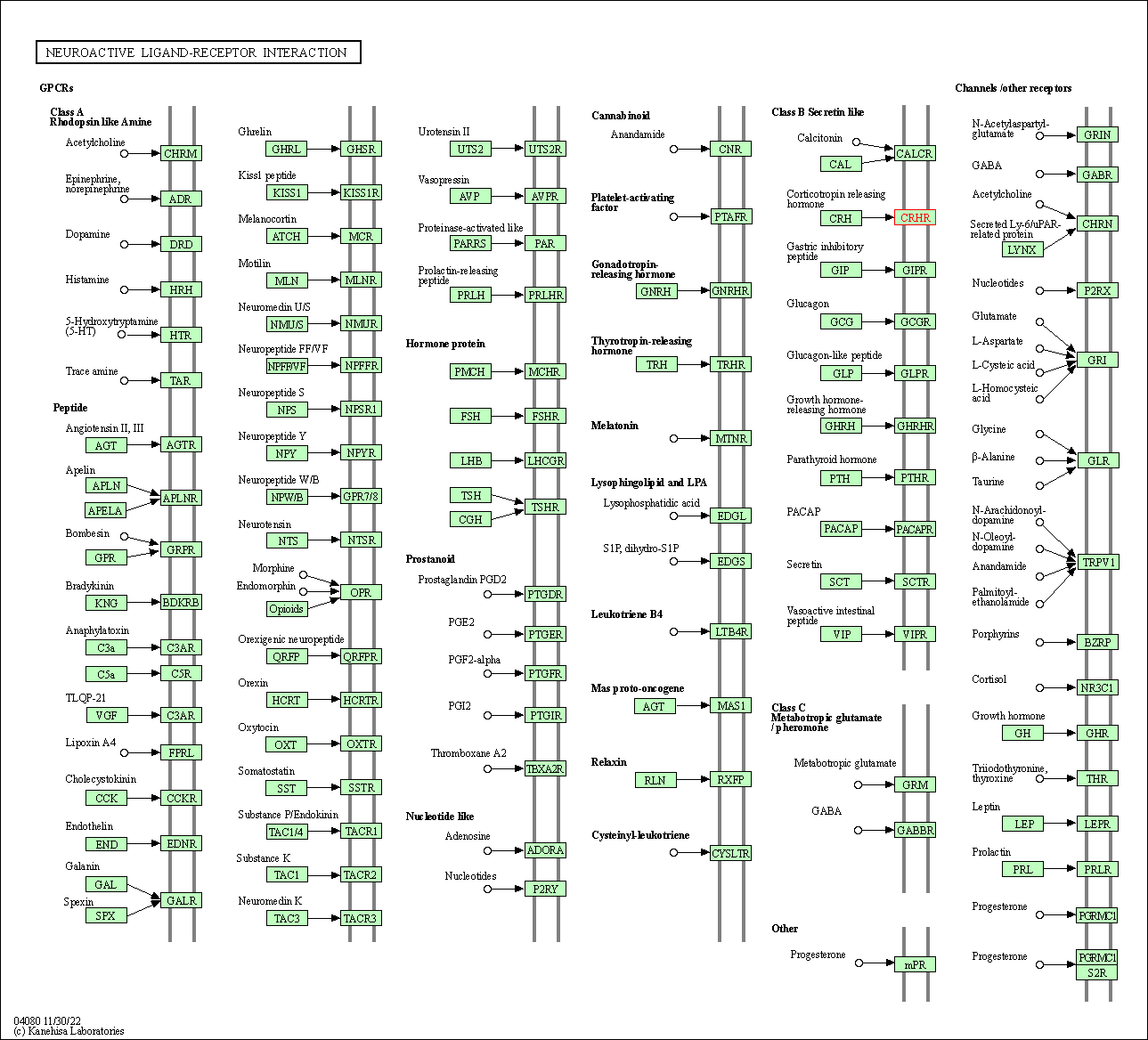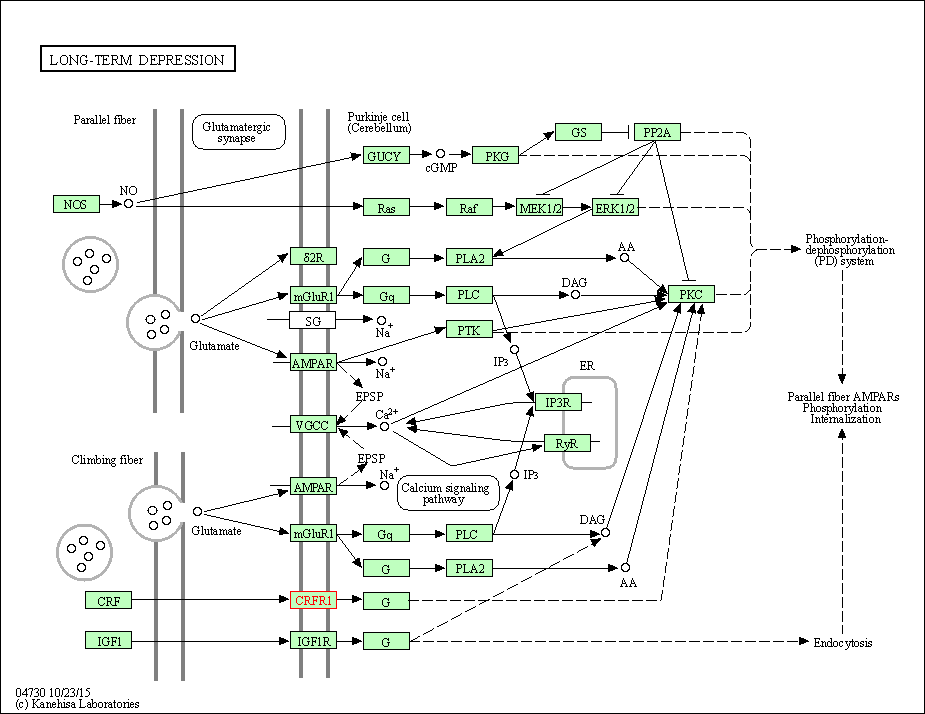Target Information
| Target General Information | Top | |||||
|---|---|---|---|---|---|---|
| Target ID |
T45262
(Former ID: TTDC00073)
|
|||||
| Target Name |
Corticotropin-releasing factor receptor 1 (CRHR1)
|
|||||
| Synonyms |
Corticotropin-releasing hormone type 1 receptor; Corticotropin-releasing hormone receptor 1; CRHR1; CRH-R 1; CRF1; CRF-R1; CRF-R; CRF-1 receptor; CRF receptor
Click to Show/Hide
|
|||||
| Gene Name |
CRHR1
|
|||||
| Target Type |
Successful target
|
[1] | ||||
| Disease | [+] 1 Target-related Diseases | + | ||||
| 1 | Staphylococcal/streptococcal disease [ICD-11: 1B5Y] | |||||
| Function |
G-protein coupled receptor for CRH (corticotropin- releasing factor) and UCN (urocortin). Has high affinity for CRH and UCN. Ligand binding causes a conformation change that triggers signaling via guanine nucleotide-binding proteins (G proteins) and down-stream effectors, such as adenylate cyclase. Promotes the activation of adenylate cyclase, leading to increased intracellular cAMP levels. Inhibits the activity of the calcium channel CACNA1H. Required for normal embryonic development of the adrenal gland and for normal hormonal responses to stress. Plays a role in the response to anxiogenic stimuli.
Click to Show/Hide
|
|||||
| BioChemical Class |
GPCR secretin
|
|||||
| UniProt ID | ||||||
| Sequence |
MGGHPQLRLVKALLLLGLNPVSASLQDQHCESLSLASNISGLQCNASVDLIGTCWPRSPA
GQLVVRPCPAFFYGVRYNTTNNGYRECLANGSWAARVNYSECQEILNEEKKSKVHYHVAV IINYLGHCISLVALLVAFVLFLRLRPGCTHWGDQADGALEVGAPWSGAPFQVRRSIRCLR NIIHWNLISAFILRNATWFVVQLTMSPEVHQSNVGWCRLVTAAYNYFHVTNFFWMFGEGC YLHTAIVLTYSTDRLRKWMFICIGWGVPFPIIVAWAIGKLYYDNEKCWFGKRPGVYTDYI YQGPMILVLLINFIFLFNIVRILMTKLRASTTSETIQYRKAVKATLVLLPLLGITYMLFF VNPGEDEVSRVVFIYFNSFLESFQGFFVSVFYCFLNSEVRSAIRKRWHRWQDKHSIRARV ARAMSIPTSPTRVSFHSIKQSTAV Click to Show/Hide
|
|||||
| 3D Structure | Click to Show 3D Structure of This Target | PDB | ||||
| HIT2.0 ID | T85RZS | |||||
| Drugs and Modes of Action | Top | |||||
|---|---|---|---|---|---|---|
| Approved Drug(s) | [+] 1 Approved Drugs | + | ||||
| 1 | Telavancin | Drug Info | Approved | Staphylococcus infection | [2] | |
| Clinical Trial Drug(s) | [+] 6 Clinical Trial Drugs | + | ||||
| 1 | Pexacerfont | Drug Info | Phase 2/3 | Anxiety disorder | [3] | |
| 2 | GSK561679 | Drug Info | Phase 2 | Major depressive disorder | [4] | |
| 3 | ONO-2333Ms | Drug Info | Phase 2 | Anxiety disorder | [5] | |
| 4 | SSR125543 | Drug Info | Phase 2 | Anxiety disorder | [6] | |
| 5 | Tildacerfont | Drug Info | Phase 2 | Congenital adrenal hyperplasia | [7] | |
| 6 | GSK586529 | Drug Info | Phase 1 | Anxiety disorder | [8] | |
| Discontinued Drug(s) | [+] 5 Discontinued Drugs | + | ||||
| 1 | CP-316,311 | Drug Info | Discontinued in Phase 2 | Mood disorder | [9] | |
| 2 | GW876008 | Drug Info | Discontinued in Phase 2 | Irritable bowel syndrome | [10] | |
| 3 | Antalarmin | Drug Info | Terminated | Depression | [13], [14] | |
| 4 | DMP-696 | Drug Info | Terminated | Anxiety disorder | [15], [16] | |
| 5 | NBI-37582 | Drug Info | Terminated | Depression | [17] | |
| Preclinical Drug(s) | [+] 1 Preclinical Drugs | + | ||||
| 1 | CRA1000 | Drug Info | Preclinical | Anxiety disorder | [11], [12] | |
| Mode of Action | [+] 2 Modes of Action | + | ||||
| Antagonist | [+] 15 Antagonist drugs | + | ||||
| 1 | Telavancin | Drug Info | [1] | |||
| 2 | Pexacerfont | Drug Info | [10] | |||
| 3 | GSK561679 | Drug Info | [18] | |||
| 4 | ONO-2333Ms | Drug Info | [19] | |||
| 5 | SSR125543 | Drug Info | [20] | |||
| 6 | Tildacerfont | Drug Info | [21] | |||
| 7 | GSK586529 | Drug Info | [18] | |||
| 8 | CP-316,311 | Drug Info | [10] | |||
| 9 | GW876008 | Drug Info | [10] | |||
| 10 | CRA1000 | Drug Info | [1] | |||
| 11 | Antalarmin | Drug Info | [22] | |||
| 12 | NBI-37582 | Drug Info | [24] | |||
| 13 | CP154,526 | Drug Info | [1] | |||
| 14 | Des-Arg(9)-[Leu(8)]-BK | Drug Info | [1] | |||
| 15 | DMP-695/696 | Drug Info | [1] | |||
| Inhibitor | [+] 6 Inhibitor drugs | + | ||||
| 1 | DMP-696 | Drug Info | [23] | |||
| 2 | BMS-561388 | Drug Info | [25] | |||
| 3 | CP-376395 | Drug Info | [26] | |||
| 4 | N-mesityl-4,6-dimethyl-3-tosylpyridin-2-amine | Drug Info | [27] | |||
| 5 | N-mesityl-6-methyl-3-tosylpyridin-2-amine | Drug Info | [27] | |||
| 6 | PD-171729 | Drug Info | [28] | |||
| Cell-based Target Expression Variations | Top | |||||
|---|---|---|---|---|---|---|
| Cell-based Target Expression Variations | ||||||
| Different Human System Profiles of Target | Top |
|---|---|
|
Human Similarity Proteins
of target is determined by comparing the sequence similarity of all human proteins with the target based on BLAST. The similarity proteins for a target are defined as the proteins with E-value < 0.005 and outside the protein families of the target.
A target that has fewer human similarity proteins outside its family is commonly regarded to possess a greater capacity to avoid undesired interactions and thus increase the possibility of finding successful drugs
(Brief Bioinform, 21: 649-662, 2020).
Human Pathway Affiliation
of target is determined by the life-essential pathways provided on KEGG database. The target-affiliated pathways were defined based on the following two criteria (a) the pathways of the studied target should be life-essential for both healthy individuals and patients, and (b) the studied target should occupy an upstream position in the pathways and therefore had the ability to regulate biological function.
Targets involved in a fewer pathways have greater likelihood to be successfully developed, while those associated with more human pathways increase the chance of undesirable interferences with other human processes
(Pharmacol Rev, 58: 259-279, 2006).
Biological Network Descriptors
of target is determined based on a human protein-protein interactions (PPI) network consisting of 9,309 proteins and 52,713 PPIs, which were with a high confidence score of ≥ 0.95 collected from STRING database.
The network properties of targets based on protein-protein interactions (PPIs) have been widely adopted for the assessment of target’s druggability. Proteins with high node degree tend to have a high impact on network function through multiple interactions, while proteins with high betweenness centrality are regarded to be central for communication in interaction networks and regulate the flow of signaling information
(Front Pharmacol, 9, 1245, 2018;
Curr Opin Struct Biol. 44:134-142, 2017).
Human Similarity Proteins
Human Pathway Affiliation
Biological Network Descriptors
|
|
|
There is no similarity protein (E value < 0.005) for this target
|
| KEGG Pathway | Pathway ID | Affiliated Target | Pathway Map |
|---|---|---|---|
| cAMP signaling pathway | hsa04024 | Affiliated Target |

|
| Class: Environmental Information Processing => Signal transduction | Pathway Hierarchy | ||
| Neuroactive ligand-receptor interaction | hsa04080 | Affiliated Target |

|
| Class: Environmental Information Processing => Signaling molecules and interaction | Pathway Hierarchy | ||
| Long-term depression | hsa04730 | Affiliated Target |

|
| Class: Organismal Systems => Nervous system | Pathway Hierarchy | ||
| Degree | 6 | Degree centrality | 6.45E-04 | Betweenness centrality | 8.31E-04 |
|---|---|---|---|---|---|
| Closeness centrality | 2.03E-01 | Radiality | 1.35E+01 | Clustering coefficient | 4.00E-01 |
| Neighborhood connectivity | 1.60E+01 | Topological coefficient | 2.09E-01 | Eccentricity | 12 |
| Download | Click to Download the Full PPI Network of This Target | ||||
| Chemical Structure based Activity Landscape of Target | Top |
|---|---|
| Drug Property Profile of Target | Top | |
|---|---|---|
| (1) Molecular Weight (mw) based Drug Clustering | (2) Octanol/Water Partition Coefficient (xlogp) based Drug Clustering | |
|
|
||
| (3) Hydrogen Bond Donor Count (hbonddonor) based Drug Clustering | (4) Hydrogen Bond Acceptor Count (hbondacc) based Drug Clustering | |
|
|
||
| (5) Rotatable Bond Count (rotbonds) based Drug Clustering | (6) Topological Polar Surface Area (polararea) based Drug Clustering | |
|
|
||
| "RO5" indicates the cutoff set by lipinski's rule of five; "D123AB" colored in GREEN denotes the no violation of any cutoff in lipinski's rule of five; "D123AB" colored in PURPLE refers to the violation of only one cutoff in lipinski's rule of five; "D123AB" colored in BLACK represents the violation of more than one cutoffs in lipinski's rule of five | ||
| Co-Targets | Top | |||||
|---|---|---|---|---|---|---|
| Co-Targets | ||||||
| Target Poor or Non Binders | Top | |||||
|---|---|---|---|---|---|---|
| Target Poor or Non Binders | ||||||
| Target Profiles in Patients | Top | |||||
|---|---|---|---|---|---|---|
| Target Expression Profile (TEP) | ||||||
| Target Affiliated Biological Pathways | Top | |||||
|---|---|---|---|---|---|---|
| KEGG Pathway | [+] 2 KEGG Pathways | + | ||||
| 1 | Neuroactive ligand-receptor interaction | |||||
| 2 | Long-term depression | |||||
| NetPath Pathway | [+] 1 NetPath Pathways | + | ||||
| 1 | TNFalpha Signaling Pathway | |||||
| Panther Pathway | [+] 1 Panther Pathways | + | ||||
| 1 | Cortocotropin releasing factor receptor signaling pathway | |||||
| Reactome | [+] 2 Reactome Pathways | + | ||||
| 1 | Class B/2 (Secretin family receptors) | |||||
| 2 | G alpha (s) signalling events | |||||
| WikiPathways | [+] 5 WikiPathways | + | ||||
| 1 | GPCRs, Class B Secretin-like | |||||
| 2 | Myometrial Relaxation and Contraction Pathways | |||||
| 3 | Corticotropin-releasing hormone | |||||
| 4 | GPCR ligand binding | |||||
| 5 | GPCR downstream signaling | |||||
| Target-Related Models and Studies | Top | |||||
|---|---|---|---|---|---|---|
| Target Validation | ||||||
| References | Top | |||||
|---|---|---|---|---|---|---|
| REF 1 | A review of drug options in age-related macular degeneration therapy and potential new agents. Expert Opin Pharmacother. 2006 Dec;7(17):2355-68. | |||||
| REF 2 | Drugs@FDA. U.S. Food and Drug Administration. U.S. Department of Health & Human Services. 2015 | |||||
| REF 3 | ClinicalTrials.gov (NCT00481325) Study of Pexacerfont (BMS-562086) in the Treatment of Outpatients With Generalized Anxiety Disorder. U.S. National Institutes of Health. | |||||
| REF 4 | ClinicalTrials.gov (NCT01187511) Effects of Corticotropin-Releasing Hormone Receptor 1 (CRH1) Antagonism on Stress-Induced Craving in Alcoholic Women With High Anxiety. U.S. National Institutes of Health. | |||||
| REF 5 | ClinicalTrials.gov (NCT00514865) Placebo-Controlled Study of ONO-2333Ms in Patients With Recurrent Major Depressive Disorder. U.S. National Institutes of Health. | |||||
| REF 6 | ClinicalTrials.gov (NCT01034995) A Trial Evaluating the Efficacy and Tolerability of SSR125543 in Outpatients With Major Depressive Disorder. U.S. National Institutes of Health. | |||||
| REF 7 | ClinicalTrials.gov (NCT05370521) A Randomized, Placebo-Controlled, Dose Escalation Study to Evaluate the Safety and Efficacy of Tildacerfont in Adult Subjects With Polycystic Ovary Syndrome (PCOS) and Elevated Adrenal Androgens. U.S.National Institutes of Health. | |||||
| REF 8 | ClinicalTrials.gov (NCT00703547) A First Time in Human Study of GSK586529 in Healthy Volunteers. U.S. National Institutes of Health. | |||||
| REF 9 | Trusted, scientifically sound profiles of drug programs, clinical trials, safety reports, and company deals, written by scientists. Springer. 2015. Adis Insight (drug id 800009248) | |||||
| REF 10 | Novel drugs and therapeutic targets for severe mood disorders. Neuropsychopharmacology. 2008 Aug;33(9):2080-92. | |||||
| REF 11 | URL: http://www.guidetopharmacology.org Nucleic Acids Res. 2015 Oct 12. pii: gkv1037. The IUPHAR/BPS Guide to PHARMACOLOGY in 2016: towards curated quantitative interactions between 1300 protein targets and 6000 ligands. (Ligand id: 3498). | |||||
| REF 12 | Trusted, scientifically sound profiles of drug programs, clinical trials, safety reports, and company deals, written by scientists. Springer. 2015. Adis Insight (drug id 800010650) | |||||
| REF 13 | URL: http://www.guidetopharmacology.org Nucleic Acids Res. 2015 Oct 12. pii: gkv1037. The IUPHAR/BPS Guide to PHARMACOLOGY in 2016: towards curated quantitative interactions between 1300 protein targets and 6000 ligands. (Ligand id: 3489). | |||||
| REF 14 | Trusted, scientifically sound profiles of drug programs, clinical trials, safety reports, and company deals, written by scientists. Springer. 2015. Adis Insight (drug id 800007484) | |||||
| REF 15 | URL: http://www.guidetopharmacology.org Nucleic Acids Res. 2015 Oct 12. pii: gkv1037. The IUPHAR/BPS Guide to PHARMACOLOGY in 2016: towards curated quantitative interactions between 1300 protein targets and 6000 ligands. (Ligand id: 3499). | |||||
| REF 16 | Trusted, scientifically sound profiles of drug programs, clinical trials, safety reports, and company deals, written by scientists. Springer. 2015. Adis Insight (drug id 800011782) | |||||
| REF 17 | Strategies for producing faster acting antidepressants. Drug Discov Today. 2005 Apr 15;10(8):578-85. | |||||
| REF 18 | Clinical pipeline report, company report or official report of GlaxoSmithKline (2009). | |||||
| REF 19 | Behavioral, biological, and chemical perspectives on targeting CRF(1) receptor antagonists to treat alcoholism. Drug Alcohol Depend. 2013 Mar 1;128(3):175-86. | |||||
| REF 20 | Pharma & Vaccines. Product Development Pipeline. April 29 2009. | |||||
| REF 21 | Clinical advances in the pharmacotherapy of congenital adrenal hyperplasia. Eur J Endocrinol. 2021 Nov 30;186(1):R1-R14. | |||||
| REF 22 | Chronic administration of the non-peptide CRH type 1 receptor antagonist antalarmin does not blunt hypothalamic-pituitary-adrenal axis responses to acute immobilization stress. Life Sci. 1999;65(4):PL53-8. | |||||
| REF 23 | In vitro intrinsic clearance-based optimization of N3-phenylpyrazinones as corticotropin-releasing factor-1 (CRF1) receptor antagonists. J Med Chem. 2009 Jul 23;52(14):4161-72. | |||||
| REF 24 | CenterWatch. Drugs in Clinical Trials Database. CenterWatch. 2008. | |||||
| REF 25 | 8-(4-Methoxyphenyl)pyrazolo[1,5-a]-1,3,5-triazines: selective and centrally active corticotropin-releasing factor receptor-1 (CRF1) antagonists. J Med Chem. 2009 May 14;52(9):3073-83. | |||||
| REF 26 | 2-aryloxy-4-alkylaminopyridines: discovery of novel corticotropin-releasing factor 1 antagonists. J Med Chem. 2008 Mar 13;51(5):1385-92. | |||||
| REF 27 | Synthesis and evaluation of 2-anilino-3-phenylsulfonyl-6-methylpyridines as corticotropin-releasing factor1 receptor ligands. Bioorg Med Chem Lett. 2006 Feb 15;16(4):934-7. | |||||
| REF 28 | Pyrazolo[1,5-a]pyrimidine CRF-1 receptor antagonists. Bioorg Med Chem Lett. 1998 Aug 18;8(16):2067-70. | |||||
If You Find Any Error in Data or Bug in Web Service, Please Kindly Report It to Dr. Zhou and Dr. Zhang.

